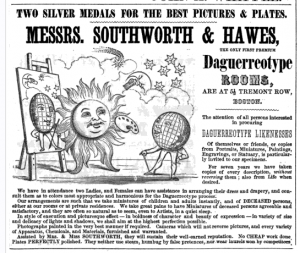Before Polaroid and Kodak or even inexpensive tintypes, daguerreotypes were the original popular means of taking pictures. The process, created by French inventor Louis Daguerre with an assist from Joseph Nicéphore Niépce, combined mercury and silver to capture images of the era’s most celebrated politicians, artists and cities.
In 1848, the daguerreotype industry had plenty of competitors and companies had to do whatever they could to get ahead. The Boston, Massachusetts, outfit known as Southworth & Hawes produced a ton of gorgeous images, but that apparently wasn’t enought ot make ends meet. They also advertised themselves as willing to create images of the recently deceased. An excerpt from the ad copy:
“Our arrangements as such that we take miniatures of children and adults instantly, and of DECEASED persons, either at our rooms or at private residences. We take great pains to have Miniatures of deceased persons agreeable and satisfactory and they are often so natural as to seem, even to Artists, in a quiet sleep.”
More Old Print Ads:
- Rubber Party Masks. (1949)
- Slimming Belt for Men. (1952)
- Non-Wilting Jockstraps. (1941)
- Alcohol-Filled Novelty Handgun. (1926)
- Ajeeb, the chess-playing automaton. (Late 1800s)
- Weltmer Insitute of Magnetic Healing. (1898)
- Cataract Electric Washer. (1920)
- Whiz Bang Pep Pills. (1920s)
- Vacutex Blackhead Face Vacuum. (1952)
- P.T. Barnum’s Greatest Show on Earth. (1876)
- Dr. Hopkins’ Electric Hair Restorer. (1868)
- Showgirl Laxatives. (1901)
- Salem Witch Spoon. (1891)
- Panti-Legs. (1961)

